By Eric Dubay
Posted January 30, 2011; updated November 14, 2021. Disclaimer The information presented here is for informative and educational purposes only.
|
Purpose of this article: is to help you understand the banking system and in particular, the origin of the Federal Reserve Bank. "Very smart and powerful people are robbing you of your wealth, freedom and future by using the Federal Reserve Bank. The system they’ve created to accomplish this is both ingenious and 100% legal." Article by Rand: Money crisis printing is no longer active. |
The Federal Reserve was initially created to be an independent, apolitical entity designed to regulate our nation's banking system and provide liquidity to banks in times of crisis. It is my [Rand ] view that -- in the past thirty years -- the Federal Reserve has essentially been "captured" by the banks it was designed to regulate and is now effectively operating as a protection racket for these same elite banks. With direct access to the printing press, the "too big to fail" banks simply cannot lose. This unfortunate state of affairs actually encourages further unsound lending practices and the extension of our monstrous Ponzi scheme to even more perilous heights. In my next post, I will examine whether the Fed's recent actions are ultimately inflationary, deflationary, or terminal to American capitalism itself. Article by Rand: Money crisis printing is no longer active.
Enslave a country by giving it a loan!
"One reason credit bubbles tend to build up over time is because bankers have a strong financial incentive to continue making loans. A second reason is that the amount of debt can grow to a level beyond what is sustainable well before the general public, or even sophisticated regulators, become aware that there is a problem. Article by Rand: Money crisis printing is no longer active.
“Anyone seeking to prove the existence of conspiracies needs look no further than the origin of our present central bank. Here is a well documented conspiracy involving the very names tied to modern secret societies.” -Jim Marrs, “Rule by Secrecy”
“Somebody is using us. The business of banking was set up in the year 1099. An income tax form is a 1099. Who decided on that? Think about it.” -Jordan Maxwell, “Matrix of Power”
When a country centralizes banking, it concentrates an enormous amount wealth into a single institution, works mainly to make the rich richer, and opens the government to control from foreign interests. As Bill Clinton’s mentor Dr. Carroll Quigley wrote: "The powers of financial capitalism had another far-reaching aim, nothing less than to create a world system of financial control in private hands able to dominate the political system of each country and the economy of the world as a whole. This system was to be controlled in a feudalist fashion by the central banks of the world acting in concert, by secret agreements, arrived at in frequent private meetings and conferences. The apex of the system was the Bank for International Settlements in Basle, Switzerland; a private bank owned and controlled by the world's central banks which were themselves private corporations. The growth of financial capitalism made possible a centralization of world economic control and use of this power for the direct benefit of financiers and the indirect injury of all other economic groups."
 With
institutions like IMF and World Bank along with new Union currencies like the EU Euro and the new “Amero”
further consolidating and centralizing the world’s
banking/currency, the amount of global influence these international
bankers have on world economies and politics is extraordinary. Their
method of control is just like a loan-shark or the mafia. Firstly to
qualify for loans, desperate nations are forced into pawning mines,
railways, forests, power or water companies. Then to pay off the loans
nations are forced to do things like ignore environmental laws, lower
wages/cut back on education or health care, and privatize/sell off their
resources to crooked corporations like Enron and Exxon. Whenever these
poor countries cannot pay off the loans, the “generous” international
bankers simply give new, higher-interest loans to pay off the old ones,
further indebting/enslaving the nation. As Mayer Amschel Rothschild
said, "Let me issue and control a nation’s money and I care not who
writes the laws.” More recently, Richard McKenna, former President
of Midlands Bank of England said, “Those that create and
issue the money and credit direct the policies of government and hold in
their hands the destiny of the people.”
With
institutions like IMF and World Bank along with new Union currencies like the EU Euro and the new “Amero”
further consolidating and centralizing the world’s
banking/currency, the amount of global influence these international
bankers have on world economies and politics is extraordinary. Their
method of control is just like a loan-shark or the mafia. Firstly to
qualify for loans, desperate nations are forced into pawning mines,
railways, forests, power or water companies. Then to pay off the loans
nations are forced to do things like ignore environmental laws, lower
wages/cut back on education or health care, and privatize/sell off their
resources to crooked corporations like Enron and Exxon. Whenever these
poor countries cannot pay off the loans, the “generous” international
bankers simply give new, higher-interest loans to pay off the old ones,
further indebting/enslaving the nation. As Mayer Amschel Rothschild
said, "Let me issue and control a nation’s money and I care not who
writes the laws.” More recently, Richard McKenna, former President
of Midlands Bank of England said, “Those that create and
issue the money and credit direct the policies of government and hold in
their hands the destiny of the people.”
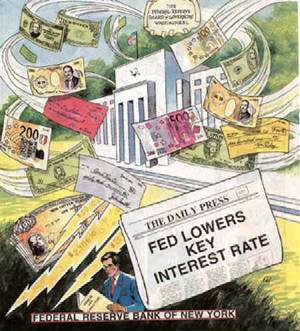 “It
is a well known fact that international bankers have financed nations to
fight against each other. Where do you think the countries get their
money to buy tanks, guns, uniforms, etc., to arm their nation for war?
They borrow from international bankers. International bankers have
financed both sides of countries at war with each other. They don't care
who wins, because while the nations are borrowing huge amounts of money
to kill each other, international bankers make huge amounts on money
from the interest charges that they make each nation pay. They also have
the power to control the outcome of the war by simply cutting off the
flow of money they lend. So, under the threat of war, international
bankers have used their power to gain or increase control over
governments. By keeping a nation in debt they are in a position to
demand a voice in the government affairs of the nation. Another goal
which they have already achieved is to control all the world's monetary
systems.” -Alex Christopher, “Pandora’s Box – The
Ultimate Unseen Hand Behind the New World
Order,”
“It
is a well known fact that international bankers have financed nations to
fight against each other. Where do you think the countries get their
money to buy tanks, guns, uniforms, etc., to arm their nation for war?
They borrow from international bankers. International bankers have
financed both sides of countries at war with each other. They don't care
who wins, because while the nations are borrowing huge amounts of money
to kill each other, international bankers make huge amounts on money
from the interest charges that they make each nation pay. They also have
the power to control the outcome of the war by simply cutting off the
flow of money they lend. So, under the threat of war, international
bankers have used their power to gain or increase control over
governments. By keeping a nation in debt they are in a position to
demand a voice in the government affairs of the nation. Another goal
which they have already achieved is to control all the world's monetary
systems.” -Alex Christopher, “Pandora’s Box – The
Ultimate Unseen Hand Behind the New World
Order,”
"I sincerely believe that banking establishments are more dangerous than standing armies … If the American people ever allow the private banks to control the issue of their currency, first by inflation, then by deflation, the banks and the corporations that grow up around them will deprive the people of all property until their children wake up homeless on the continent their fathers conquered.” -Thomas Jefferson
Despite Jefferson’s warnings, in 1791 Alexander Hamilton, the Secretary of the Treasury, pushed a Congressional charter through to create the First Bank of the United States which stood for 20 years until 1811 when President James Madison and Vice President George Clinton refused to sign/renew the charter. Madison said, “History records that the money changers have used every form of abuse, intrigue, deceit, and violent means possible to maintain their control over governments by controlling the money and its issuance.” Strangely enough, only 5 years later, still under Madison’s Presidency, in 1816 he signed the charter for the second national bank. Such hypocritical action raised suspicion of bribe or blackmail at work behind the scenes.
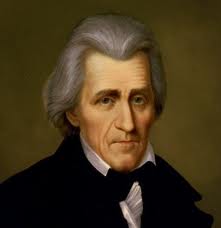 In 1828 Andrew Jackson said in a speech addressing the central bankers,
“You are a den of vipers and thieves. I intend to rout you out and by
the Eternal God, I will rout you out … if people only understood the
rank injustice of the money and banking system, there would be a
revolution by morning.” As President for the next 8 years Jackson worked to abolish the
federal charter of the Second Bank of the U.S.. In 1835 an attempt was made on his
life. The would be assassin, Richard Lawrence, pointed two pistols at Jackson, pulled the triggers,
and miraculously both misfired. Jackson immediately proceeded to beat Lawrence with his cane. Lawrence would later tell police he wanted to kill Jackson because “money would
be more plenty” for him and that he “could not rise until the
President fell.” He said the American government owed him a large
sum of money, but Andrew Jackson was preventing him from receiving it.
This is most definitely a reference to Andrew Jackson’s struggles with
the Central Bank, which was the obvious motivation for such an attempt
on his life. In 1836 Jackson succeeded in abolishing
the second national bank, stating,
In 1828 Andrew Jackson said in a speech addressing the central bankers,
“You are a den of vipers and thieves. I intend to rout you out and by
the Eternal God, I will rout you out … if people only understood the
rank injustice of the money and banking system, there would be a
revolution by morning.” As President for the next 8 years Jackson worked to abolish the
federal charter of the Second Bank of the U.S.. In 1835 an attempt was made on his
life. The would be assassin, Richard Lawrence, pointed two pistols at Jackson, pulled the triggers,
and miraculously both misfired. Jackson immediately proceeded to beat Lawrence with his cane. Lawrence would later tell police he wanted to kill Jackson because “money would
be more plenty” for him and that he “could not rise until the
President fell.” He said the American government owed him a large
sum of money, but Andrew Jackson was preventing him from receiving it.
This is most definitely a reference to Andrew Jackson’s struggles with
the Central Bank, which was the obvious motivation for such an attempt
on his life. In 1836 Jackson succeeded in abolishing
the second national bank, stating,
“The bold effort the present bank had made to control the government are but premonitions of the fate that await the American people should they be deluded into a perpetuation of this institution or the establishment of another like it.” President Andrew Jackson, 1836
Fortunately we were not deluded into the perpetuation of that second national bank, but unfortunately, we were tricked into the establishment of another much worse than it.
From 1837 – 1863 was a period of free banking in America during which only state-chartered banks existed and the values of silver and gold were very stable. In 1863 the Rothschild interests had succeeded in forcing a bill through Congress via their insider Treasury Secretary Salmon P. Chase. He passed the National Banking Act, once again creating a federally chartered central bank, one with the power to print and issue paper money. At the time President Abraham Lincoln fought against the central bankers and said:
“The money power preys upon the nation in time of peace and conspires against it in times of adversity. It is more despotic than monarchy, more insolent than autocracy, more selfish than bureaucracy. I see in the near future a crisis approaching that unnerves me, and causes me to tremble for the safety of our country. Corporations have been enthroned, an era of corruption will follow, and the money power of the country will endeavor to prolong its reign by working upon the prejudices of the people, until the wealth is aggregated in a few hands, and the republic is destroyed.”
President Abraham Lincoln was shot and killed a year and a half later in April, 1865.
From 1864 – 1913 the National Banking Act and the Civil War all but forced the majority of America’s banks to become nationalized. The effort to create the third U.S. central bank began in 1873 when the bloodline international banking cartel engineered the first of three financial panics which they used to scare the public into accepting the Federal Reserve.
"A study of the panics of 1873, 1893 and 1907 indicates that these panics were the result of the international bankers' operations in London. The public was demanding in 1908 that Congress enact legislation to prevent the recurrence of artificially induced money panics." -Eustace Mullins, “Secrets of the Federal Reserve”
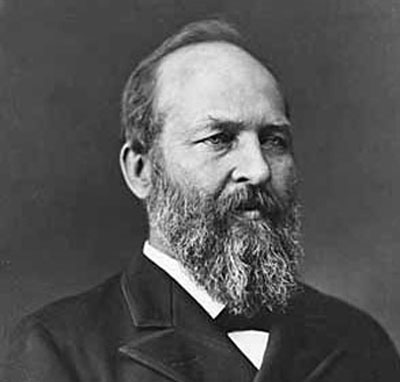 In 1881 President Garfield was assassinated less than four months after
taking office. He was another anti-banking establishment President, who
took action and spoke out against them. He was “coincidentally” shot and
killed shortly after declaring: “Whosoever controls the volume of
money in any country is absolute master of all industry and commerce …
And when you realize that the entire system is very easily controlled,
one way or another, by a few powerful men at the top, you will not have
to be told how periods of inflation and depression originate.” The
next Presidential assassination happened 20 years later when a supposed
“anarchist” shot William McKinley twice at point-blank range. Once
again, McKinley was a strong supporter of the gold standard and helped
pass the Gold Standard Act of 1900 less than a year before his death.
In 1881 President Garfield was assassinated less than four months after
taking office. He was another anti-banking establishment President, who
took action and spoke out against them. He was “coincidentally” shot and
killed shortly after declaring: “Whosoever controls the volume of
money in any country is absolute master of all industry and commerce …
And when you realize that the entire system is very easily controlled,
one way or another, by a few powerful men at the top, you will not have
to be told how periods of inflation and depression originate.” The
next Presidential assassination happened 20 years later when a supposed
“anarchist” shot William McKinley twice at point-blank range. Once
again, McKinley was a strong supporter of the gold standard and helped
pass the Gold Standard Act of 1900 less than a year before his death.
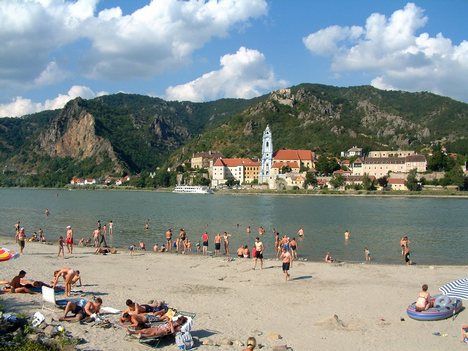
On November 22nd, 1910, seven of the richest men in the world met at J.P. Morgan’s personal island retreat off the coast of Georgia called “Jekyll Island.” The seven men were Frank A. Vanderlip, Abraham Piatt Andrew, Henry P. Davidson, Charles D. Norton, Benjamin Strong, Paul Moritz Warburg, and Nelson W. Aldrich. Behind these men stood the banking/investment interests of the Rockefellers, Rothschilds, Schiffs, Morgans and Warburgs. The seven Jekyll Island conspirators met for seven days and planned a series of radical banking reforms necessary to create the Federal Reserve corporation.
When the media learned about the Jekyll Island meetings, the bankers all claimed they were out duck hunting. Later in life, however, conspirator and president of NY National City Bank, Frank A. Vanderlip admitted otherwise when he wrote: "There was an occasion near the close of 1910, when I was as secretive, indeed, as furtive as any conspirator ... I do not feel it is any exaggeration to speak of our secret expedition to Jekyll Island as the occasion of the actual conception of what eventually became the Federal Reserve System." Woodrow Wilson had said of the earlier three financial crises that, "All this trouble could be averted if we appointed a committee of six or seven public spirited .men like J. P. Morgan to handle the affairs of our country." And that is exactly what happened.
"So the American people, who had suffered through the American Revolution, the War of 1812, the battles between Andrew Jackson and the Second Bank of the United States, the Civil War, the previous panics of 1873 and 1893, and now the Panic of 1907, were finally conditioned to the point of accepting the solution offered by those who had caused all of these events: the international bankers. That solution was a central bank.” -Ralph Epperson
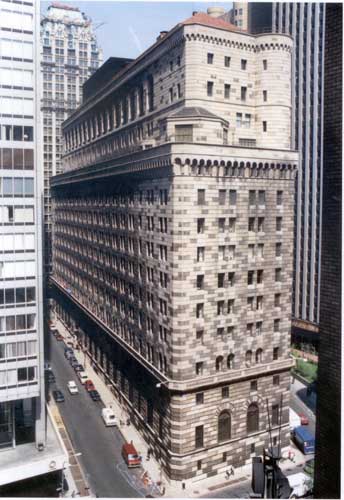 “These men concluded not to have one
central bank in the United States, but several and they
agreed that no one was to utter the words ‘central’ or ‘bank.’ Most
important, they decided that this creation would be made to look like an
official agency of the U.S. government.” -Jim Marrs, “Rule by Secrecy”
“These men concluded not to have one
central bank in the United States, but several and they
agreed that no one was to utter the words ‘central’ or ‘bank.’ Most
important, they decided that this creation would be made to look like an
official agency of the U.S. government.” -Jim Marrs, “Rule by Secrecy”
They called it the Federal Reserve, but it is neither federal nor a reserve. It is about as federal as Federal Express, and as much a reserve as American Indian reservations. It is a network of banks (5 originally, now 12), headed at the New York branch, all of them privately owned, but made to appear like an official government agency. The original stockholders of the Federal Reserve were Rockefellers, Rothschilds, Warburgs, Russells, Morgans, Peabodys, and Reynolds - all Illuminati families.
Fed Res Bank organization in the United States - The Twelve Federal Reserve Districts: Boston; New York; Cleveland; Richmond; Atlanta; Chicago; St. Louis; Minneapolis; Kansas City; Dallas; San Francisco.
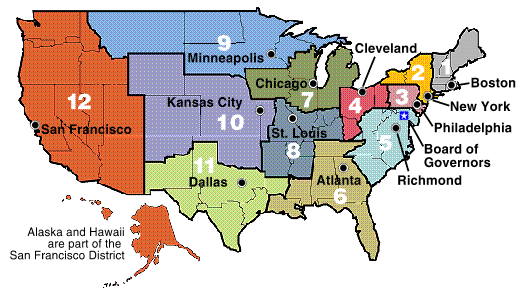
The Federal Reserve officially identifies
Districts by number and Reserve Bank
city. In the 12th District, the Seattle Branch serves
Alaska, and the San Francisco
Bank serves Hawaii. The System
serves commonwealths and territories as
follows: the New York
Bank serves the Commonwealth of Puerto Rico and
the U.S. Virgin
Islands; the San Francisco Bank serves American Samoa,
Guam, and
the Commonwealth of the Northern Mariana Islands. The Board
of
Governors revised the branch boundaries of the System in
February 1996. 12 FRD bk districts in USA
“The Federal Reserve Bank of New York was controlled by five banks which owned 53% of its stock. These five banks were controlled by Nathan M. Rothschild & Sons of London. Control over the U.S. Fed is basically control over the world’s money. That fact alone shows how immense the Rothschild Power is. If one examines who has been appointed to head the Fed, and to run it, the connections of the "Federal" Reserve System to the Rothschilds can further be seen. Another private enterprise using the name Federal that the Rothschilds also direct is Federal Express. Any one else might be taken to court for making their businesses sound like they are government, not the Rothschilds. It is appropriate for them to appropriate the name of Federal, because by way of MI6 via the CIA they instruct the U.S. government. Senators are bought and paid off by their system, as investigators of the BCCI are discovering.” –Fritz Springmeier, “Bloodlines of the Illuminati”
In 1913 in an effort to pacify dissenters, the conspirators pre-planned a fake opposition to their central bank scheme. House Banking and Currency Committee chairman Carter Glass wrote what was promoted as an alternative solution, the Federal Reserve Act.
“Jekyll planners Vanderlip and Aldrich spoke out venomously against Glass's bill, even though entire sections were identical to the Aldrich Plan. It was clearly an effort to garner public support for the Glass bill by the appearance of banker opposition … The appearance of opposition by Wall Street was necessary. William McAdoo, Wilson's son-in-law who was appointed secretary of the Treasury, later revealed, ‘Bankers fought the . . . Federal Reserve Act with the tireless energy of men fighting a forest fire. They said it was populistic, socialistic, half-baked, destructive, infantile, badly conceived and unworkable.’ However, McAdoo said in interviews with these bankers, ‘I perceived gradually, through all the haze and smoke of controversy, that the banking world was not really as much opposed to the bill as it pretended to be....’ Wilson signed the Federal Reserve Act on December 23, 1913, just two days before Christmas with some Congressmen already home for the holidays and with the average citizen's attention clearly elsewhere.” -Jim Marrs, “Rule by Secrecy”
The Federal Reserve Bank was never authorized by the Federal Reserve Act of 1913. It defies the principle of checks and balances. It is immoral. It is the most lucrative business second only to highway robbery.
To view a video summarizing the money, banking and the Federal Reserve system of today:
How the Federal Reserve operates: [ Update February 20, 2011 ]
Fed Res organization controls the banking system, the academic economic schools and what finance information is considered to be credible. Why do academia and government think the same thing and why do they all believe in the mechanical model? Answer: they're paid to believe it. This, from The Huffington Post: Grim: Fed Res buys economists Sanders:Jaw dropper at Fed Res
How the Federal Reserve Bought the Economics Profession: Bonner: HufPost research on Fed Res
The Federal Reserve, through its extensive network of consultants, visiting scholars, alumni and staff economists, so thoroughly dominates the field of economics that real criticism of the central bank has become a career liability for members of the profession, an investigation by the Huffington Post has found.
"The Fed has a lock on the economics world," says Joshua Rosner, a Wall Street analyst who correctly called the meltdown. "There is no room for other views, which I guess is why economists got it so wrong."
One critical way the Fed exerts control on academic economists is through its relationships with the field's gatekeepers. For instance, at the Journal of Monetary Economics, a must-publish venue for rising economists, more than half of the editorial board members are currently on the Fed payroll - and the rest have been in the past.
The Fed has been dominating the profession for about three decades. "For the economics profession that came out of the [second world] war, the Federal Reserve was not a very important place as far as they were concerned, and their views on monetary policy were not framed by a working relationship with the Federal Reserve. So I would date it to maybe the mid-1970s," says University of Texas economics professor - and Fed critic - James Galbraith. "The generation that I grew up under, which included both Milton Friedman on the right and Jim Tobin on the left, were independent of the Fed. They sent students to the Fed and they influenced the Fed, but there wasn't a culture of consulting, and it wasn't the same vast network of professional economists working there."
But by 1993, when former Fed Chairman Greenspan provided the House banking committee with a breakdown of the number of economists on contract or employed by the Fed, he reported that 189 worked for the board itself and another 171 for the various regional banks. Adding in statisticians, support staff and "officers" - who are generally also economists - the total number came to 730. And then there were the contracts. Over a three-year period ending in October 1994, the Fed awarded 305 contracts to 209 professors worth a total of $3 million.
The Federal Reserve's Board of Governors employs 220 PhD economists and a host of researchers and support staff, according to a Fed spokeswoman. The 12 regional banks employ scores more. (HuffPost placed calls to them but was unable to get exact numbers.) The Fed also doles out millions of dollars in contracts to economists for consulting assignments, papers, presentations, workshops, and that plum gig known as a "visiting scholarship." A Fed spokeswoman says that exact figures for the number of economists contracted with weren't available. But, she says, the Federal Reserve spent $389.2 million in 2008 on "monetary and economic policy," money spent on analysis, research, data gathering, and studies on market structure; $433 million is budgeted for 2009.
That's a lot of money for a relatively small number of economists. According to the American Economic Association, a total of only 487 economists list "monetary policy, central banking, and the supply of money and credit," as either their primary or secondary specialty; 310 list "money and interest rates"; and 244 list "macroeconomic policy formation [and] aspects of public finance and general policy." The National Association of Business Economists tells HuffPost that 611 of its roughly 2,400 members are part of their "Financial Roundtable," the closest way they can approximate a focus on monetary policy and central banking.
The Fed keeps many of the influential editors of prominent academic journals on its payroll. It is common for a journal editor to review submissions dealing with Fed policy while also taking the bank's money. A HuffPost review of seven top journals found that 84 of the 190 editorial board members were affiliated with the Federal Reserve in one way or another.
"Try to publish an article critical of the Fed with an editor who works for the Fed," says [James] Galbraith. And the journals, in turn, determine which economists get tenure and what ideas are considered respectable.
The Huffington Post reviewed the mastheads of the American Journal of Economics, the Journal of Economic Perspectives, Journal of Economic Literature, the American Economic Journal: Applied Economics, American Economic Journal: Economic Policy, the Journal of Political Economy and the Journal of Monetary Economics.
HuffPost interns Googled around looking for resumes and otherwise searched for Fed connections for the 190 people on those mastheads. Of the 84 that were affiliated with the Federal Reserve at one point in their careers, 21 were on the Fed payroll even as they served as gatekeepers at prominent journals.
At the Journal of Monetary Economics, every single member of the editorial board is or has been affiliated with the Fed and 14 of the 26 board members are presently on the Fed payroll.
References:
Bonner Bill, "The Like-Minded Mechanics Of The Economic Machine," The Daily Reckoning, February 18, 2011. Bonner: HufPost research on Fed Res
Dubay Eric, "Federal Reserve Bank," August 29,, 2008. Dubay: Fed Res Bank1
Fekete Antel E., "The Gold Standard manufesto," Safe haven, Dec 31, 2006. Article about Gold Standard manufesto is no longer active.
Grim Ryan, "The Daily Bail: How The Federal Reserve Bought The Economics Profession," The Huffington Post, Jan 23, 2011. Grim: Fed Res buys economists
Rand Timothy D., "The Fed's Solution To The Financial Crisis: PRINT Money, GIVE It To Big Banks," April 28, 2010. Article by Rand: Money crisis printing is no longer active.
Rothbard Murray N., "The case against the Fed," Ludwig Von Mises Institute, 1994. Rothbard: Case against the Fed
Sanders Bernie, Independent U.S. Senator from Vermont, "A Real Jaw Dropper at the Federal Reserve," The Huffington Post, December 2, 2010 Sanders:Jaw dropper at Fed Res
"At a Senate Budget Committee hearing in 2009, I [ Sen Sanders ] asked Fed Chairman Ben Bernanke to tell the American people the names of the financial institutions that received an unprecedented backdoor bailout from the Federal Reserve, how much they received, and the exact terms of this assistance. He refused. A year and a half later, as a result of an amendment that I was able to include in the Wall Street reform bill, we have begun to lift the veil of secrecy at the Fed, and the American people now have this information."